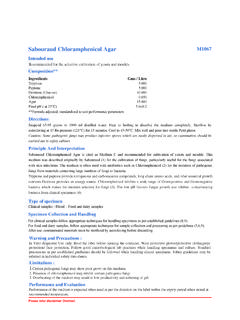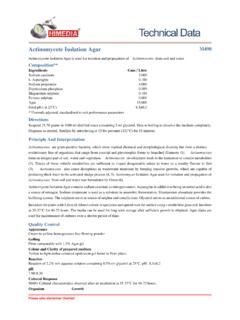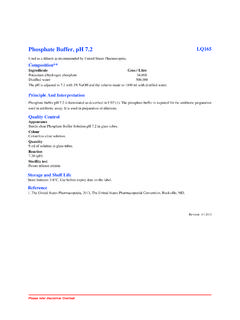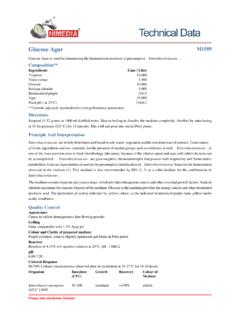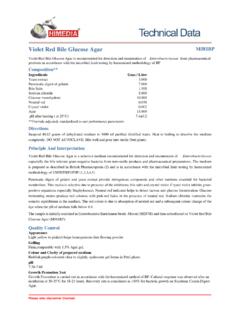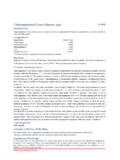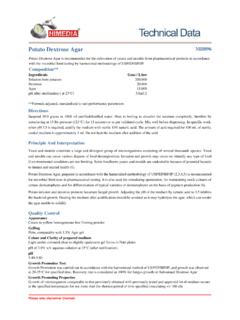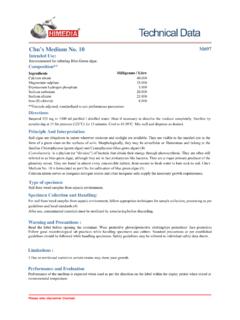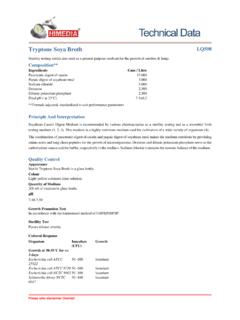Transcription of Mueller Hinton Agar - himedialabs.com
1 Mueller Hinton Agar M173. Intended Use: Recommended for determination of susceptibility of microorganisms to antimicrobial agents isolated from clinical samples. Composition**. Ingredients Gms / Litre HM infusion B from # Acicase ## Starch Agar Final pH ( at 25 C) **Formula adjusted, standardized to suit performance parameters # - Equivalent to Beef infusion from ## - Equivalent to Casein acid hydrolysate Directions Suspend grams in 1000 ml distilled water . Heat to boiling to dissolve the medium completely. Sterilize by autoclaving at 15 lbs pressure (121 C) for 15 minutes. Cool to 45-50 C. Mix well and pour into sterile Petri plates. Note: The performance of this batch has been tested and standardised as per the current CLSI (formerly, NCCLS). document M6-protocols for Evaluating Dehydrated Mueller Hinton Agar.
2 Principle And Interpretation The Mueller Hinton formulation was originally developed as a simple, transparent agar medium for the cultivation of pathogenic Neisseria species (1). Other media were subsequently developed that replaced the use of Mueller Hinton Agar for the cultivation of pathogenic Neisseria species, but it became widely used in the determination of sulfonamide resistance of gonococci and other organisms. Mueller Hinton Agar is now used as a test medium for antimicrobial susceptibility testing (2). Mueller Hinton Agar is recommended for the diffusion of antimicrobial agents impregnated on paper disc through an agar gel as described in CLSI Approved Standard (3). Mueller Hinton Agar has been selected by the CLSI for several reasons: i. It demonstrates good batch-to-batch reproducibility for susceptible testing.
3 Ii. It is low in sulfonamide, trimethoprim and tetracycline inhibitors. iii. It supports the growth of most non-fastidious bacterial pathogens and iv. Many data and much experience regarding its performance have been recorded (9). Kirby-Bauer et al recommended this medium for performing antibiotic susceptibility tests using a single disc of high concentration (4). WHO Committee on Standardization of Susceptibility Testing has accepted Mueller Hinton Agar for determining the susceptibility of microorganisms because of its reproducibility (5). Mueller Hinton Agar with 5% sheep blood and Mueller Hinton Agar with Hemoglobin have been recommended for antimicrobial susceptibility testing of Streptococcus pneumoniae and Haemophilus influenzae . HM infusion B from and acicase provide nitrogenous compounds, carbon, sulphur and other essential nutrients.
4 Starch acts as a protective colloid against toxic substances present in the medium. Starch hydrolysis yields dextrose, which serves as a source of energy. These ingredients are selected for low thymine and thymidine content as determined by MIC values for Enterococcus faecalis with sulfamethoxazoletrimethoprim (SXT). The Kirby-Bauer procedure is based on agar diffusion of antimicrobial substances impregnated on paper discs. This method employs disc with a single concentration of antimicrobial agent and the zone diameters observed are correlated with minimum inhibitory concentration (MIC) values (1, 2, 6). A standardized suspension of the organism is swabbed over the entire surface Please refer disclaimer Overleaf. HiMedia Laboratories Technical data of the medium. Paper discs impregnated with specific amounts of antimicrobial agents are then placed on the surface of the medium, incubated and zones of inhibition around each disc are measured.
5 The susceptibility is determined by comparing with CLSI standards (7). The various factors, which influence disc diffusion susceptibility tests, are agar depth, disc potency, inoculum concentration, pH of the medium and beta-lactamase production by test organisms (7, 9). Mueller Hinton Agar is not appropriate for assay by disc diffusion method with slow growing organisms, anaerobes and capnophiles. With slow growing organisms, increased incubation may cause deterioration of diffusing antibiotic and produce unprecise readings (8). Type of specimen Clinical samples : Pure cultures isolated from urine , stool, blood etc. Specimen Collection and Handling For clinical samples follow appropriate techniques for handling specimens as per established guidelines (10,11). Warning and Precautions In Vitro diagnostic use only.
6 Read the label before opening the container. Wear protective gloves/protective clothing/. eye protection/face protection. Follow good microbiological lab practices while handling specimens and culture. Standard precautions as per established guidelines should be followed while handling clinical specimens. safety guidelines may be referred in individual safety data sheets. Limitations This medium is recommended for susceptibility testing of pure cultures only. Inoculum density may effect the zone size. Heavy inoculum may result in smaller zones or too less inoculum may result in bigger zones. Fastidious organisms may not grow on this medium and may require supplementation of blood. Fastidious anarobes may not grow on this medium. As antimicrobial susceptibility is carried with antibiotic disc, proper storage of the disc is desired which may effect the potency of the disc.
7 Under certain circumstances, the in vitro results of antibiotic susceptibility may not show the same in vivo Performance and Evaluation Performace of the medium is expected when used as per the direction on the label within the expiry period when stored at recommended temperature. Quality Control Appearance Cream to yellow homogeneous free flowing powder Gelling Firm, comparable with agar gel. Colour and Clarity of prepared medium Light amber coloured clear to slight opalscent gel froms in Petri plates. Reaction Reaction of w/v aqueous solution at 25 C. pH : pH. Cultural Response Cultural characteristics observed after incubation at 30-35 C for 18 -24 hours for bacterial cultures. For testing : The medium was supplemented with 5% Sheep blood and incubated at 35 C for 16-18 hours at 5% CO2.
8 For testing : The medium was supplemented with 5g/l of Yeast extract & 2 vials /l of Haemophilus Growth Supplement (FD117 containing 15 mg/l of Haematin + 15 mg/l of NAD) and incubated at 35 C for 20-24 hours at 5% CO2. Antibiotic Sensitivity test Various discs were tested for standard ATCC strains and zone of inhibition were measured after an incubation 30-35 C for 18 hours. (As per the latest CLSI Protocol M6 & Standards as per the current CLSI M100). Thymine/Thymidine Content # The zones for these discs are indicative of the Thymine/Thymidine content of the medium. Divalent Cation Content Please refer disclaimer Overleaf. HiMedia Laboratories Technical data $ The zones for these discs are indicative of the Divalent Cation content of the medium Cultural Response Organism Growth Standard ZoneZone of inhibition Observed Escherichia coli ATCC luxuriant 25922 (00013*).
9 Cephalothin CEP 30mcg 29-37 mm 29 -37 mm Chloramphenicol C 30 mcg 21-27 mm 21 -27 mm Co-Trimoxazole COT 25 23-29 mm 23 -29 mm mcg #. Cefotaxime CTX 30 mcg 29-35 mm 29 -35 mm Gentamicin GEN 10 mcg 19-26 mm 19 -26 mm Sulphafurazole SF 300 mcg 15-23 mm 15 -23 mm Staphylococcus aureus luxuriant subsp. aureus ATCC. 25923 (00034*). Co-Trimoxazole COT 25 # 20 mm (Clear >=20 mm mcg # zone). Cefoxitin CX 30 mcg 23-29 mm 23 -29 mm Erythromycin E 15 mcg 22-30 mm 22 -30 mm Linezolid LZ 30 mcg 25-32 mm 25 -32 mm Oxacillin OX 1mcg 18-24 mm 18 -24 mm Pristinomycin RP 15 mcg 21-28 mm 21 -28 mm Tetracycline TE 30 mcg $ 18-25 mm 18 -25 mm Ciprofloxacin CIP 5mcg 22-30 mm 22 -30 mm Pseudomonas aeruginosa luxuriant ATCC 27853 (00025*). Ceftazidime CAZ 30 mcg 22-29 mm 22 -29 mm Ciprofloxacin CIP 5mcg 30-40 mm 30 -40 mm Tobramycin TOB 10 mcg $ 19-25 mm 19 -25 mm Amikacin AK 30 mcg $ 18-26 mm 18 -26 mm Aztreonam AT 3mcg 23-29 mm 23 -29 mm Cephotaxime CTX 30 mcg 18-22 mm 18 -22 mm Gentamicin GEN 10 mcg $ 16-21 mm 16 -21 mm Imipenem IPM 10 mcg 20-28 mm 20 -28 mm Piperacillin PI 100 mcg 12-18 mm 25 -33 mm Escherichia coli ATCC luxuriant 35218.
10 Amoxyclav AMC 30 mcg 18-24 mm 18 -24 mm Piperacillin/Tazobactam PIT 24-30 mm 24 -30 mm 100/10 mcg Ticarcillin TI 75 mcg 6 mm 6 -6 mm Ticarcillin/Clavulanic acid 20-28 mm 20 -28 mm TCC 75/10mcg Ampicillin AMP 10 mcg 16-22 mm 16 -22 mm Ampicillin/Sulbactam A/S 29-37 mm 29 -37 mm 10/10 mcg Enterococcus faecalis luxuriant ATCC 29212 (00087*). Trimethoprim TR 5 mcg # # 20 mm >=20 mm Vancomycin VA 30 mcg 17-21 mm 17 -21 mm Staphylococcus aureus luxuriant subsp. aureusATCC 43300. (MRSA) (00211*). Oxacillin OX 1 mcg Very Hazy to No zone No Zone Key : *Corresponding WDCM numbers. Please refer disclaimer Overleaf. HiMedia Laboratories Technical data Storage and Shelf Life Store between 10-30 C in a tightly closed container and the prepared medium at 20-30 C. Use before expiry date on the label.

